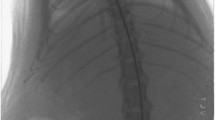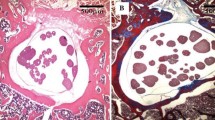Abstract
Reduction of blood flow in compressed nerve roots is considered as one important mechanism of induction of neurogenic intermittent claudication in lumbar spinal canal stenosis. Vascular endothelial growth factor (VEGF) is a potent stimulator of angiogenesis, and is increased in expression in hypoxic conditions. The objective of this study was to examine if cauda equina compression affects motor function and induces expression of VEGF and angiogenesis. The cauda equina was compressed by placing a piece of silicone rubber into the L5 epidural space. Walking duration was examined by rota-rod testing. The compressed parts of the cauda equina and L5 dorsal root ganglion (DRG) were removed at 3, 7, 14, or 28 days after surgery, and processed for immunohistochemistry for VEGF and Factor VIII (marker for vascular endothelial cells). Numbers of VEGF-immunoreactive (IR) cells and vascular density were examined. Walking duration was decreased after induction of cauda equina compression. The number of VEGF-IR cells in the cauda equina and DRG was significantly increased at 3, 14, and 28 days after cauda equina compression, compared with sham-operated rats (P < 0.05). Vascular density in the cauda equina was not increased at any of the time points examined. Cauda equina compression decreased walking duration, and induced VEGF expression in nerve roots and DRG.





Similar content being viewed by others
References
Baker AR, Collins TA, Poter RW et al (1995) Laser doppler study of procaine cauda equina blood flow. The effect of electrical stimulation of the rootlets during single and double site, low pressure compression of the cauda equina. Spine 20:660–664
Banai S, Chandra M, Lazarovici et al (1994) Upregulation of vascular endothelial growth factor expression induced by myocardial ischemia: implication for coronary angiogenesis. Cardiovasc Res 28:1176–1179
Ferrara N, Davis-Smyth T (1997) The biology of vascular endothelial growth factor. Endocr Rev 18:4–25
Hayashi T, Abe K, Suzuki H et al (1997) Rapid induction of vascular endothelial growth factor gene expression after transient middle cerebral artery occlusion in rats. Stroke 28:2039–2044
Hayashi T, Sakurai M, Abe K et al (1999) Expression of angiogenic factor in rabbit spinal cord after transient ischemia. Neuropathol Appl Neurobiol 25:63–71
Jespersen SM, Hansen ES, Hoy K et al (1995) Two-level spinal stenosis in minipig. Hemodynamic effect of exercise. Spine 20:2765–2773
Jin K, Zhu Y, Sun Y et al (2002) Vascular endothelial growth factor (VEGF) stimulates neurogenesis in vitro and in vivo. Proc Natl Acad Sci USA 99:11946–11950
Kikuchi S, Konno S, Kayama S et al (1996) Increased resistance to acute compression injury in chronically compressed spinal nerve roots: an experimental study. Spine 21:2544–2550
Konno S, Arai I, Otani K et al (2001) Effects of beraprost sodium on canine cauda equina function and blood flow using a chronic spinal cord compression model. J Spinal Disord 14:336–338
Kovacs Z, Ikezaki K, Samoto K et al (1996) VEGF and flt: expression time kinetics in rat brain infarction. Stroke 27:1865–1873
Matsunaga T, Warltier DC, Tessmer J et al (2003) Expression of VEGF, Angiopoietins-1 and -2 during ischemia-induced coronary angiogenesis. Am J Physiol Heart Circ 285:H352–H358
Ogunshola OO, Antic A, Donoghue MJ et al (2002) Paracrine and Autocrine functions of neuronal vascular endothelial growth factor (VEGF) in the central nervous system. J Biol Chem 277:11410–11415
Olmarker K, Rydevik B, Holm S et al (1989) Effects of experimental graded compression on blood flow in spinal nerve roots. A vital microscopic study on the porcine cauda equina. J Orthop Res 7:817–823
Ooi Y, Mita F, Satoh Y (1990) Myeloscopic study on lumbar spinal canal stenosis with special reference to intermittent claudication. Spine 15:544–549
Otani K, Kayama S, Mao GP et al (1997) Tolerance to acute compression injury and recovery of nerve function in chronically compressed spinal nerve root: experimental study. J Orthop Sci 2:266–270
Otani K, Kikuchi S, Konno S et al (2001) Blood flow measurement in experimental chronic cauda equina compression in dogs: changes in blood flow at various conditions. J Spinal Disord 14:343–346
Pola R, Gaetani E, Flex A et al (2003) Peripheral nerve ischemia: apolipoprotein E deficiency results in impaired functional recovery and reduction of associated intraneural angiogenic response. Exp Neurol 184:264–273
Sekiguchi M, Kikuchi S, Myers RR (2004) Experimental spinal stenosis. Relationship between degree of cauda equina compression, neuropathology, and pain. Spine 29:1105–1111
Shweiki D, Itin D, Soffer D et al (1992) Vascular endothelial growth factor induced by hypoxia may mediate Hypoxia-initiated angiogenesis. Nature 359:843–845
Skold M, Cullheim S, Hammarberg H et al (2000) Induction of VEGF and VEGF receptors in the spinal cord after mechanical spinal injury and prostaglandin administration. Eur J Neurosci 12:3675:3686
Sondell M, Lundborg G, Kanje M (1999) Vascular endothelial growth factor has neurotrophic activity and stimulates axonal outgrowth, enhancing cell survival and schwann cell proliferation in the peripheral nervous system. J Neurosci 19:5731–5740
Sondell M, Sundler F, Kanje M (2000) Vascular endothelial growth factor is a neurotrophic factor which stimulates axonal outgrowth through the flk-1 receptor. Eur J Neurosci 12:4243–4254
Takahashi K, Olmarker K, Holm S et al (1993) Double-level cauda equina compression: an experimental study with continuous monitoring of intraneural blood flow in the porcine cauda equina. J Orthop Res 11:104–109
Takahashi N, Konno S, Kikuchi S (2003) Histologic and functional study on cauda equina adhesion induced by multiple level laminectomy. Spine 28:4–8
Takenobu K, Katsube N, Marsala M et al (2001) Model of neuropathic intermittent claudication in the rat: methodology and application. J Neursci Meth 104:191–198
Widenfalk J, Lipson A, Jubran M et al (2003) Vascular endothelial growth factor improves functional outcome and decreases secondary degeneration in experimental spinal cord contusion injury. Neurosci 120:951–960
Yamaguchi K, Murakami M, Takahashi K et al (1999) Behavioral and morphologic studies of the chronically compressed cauda equina: experimental model of lumbar spinal stenosis in the rats. Spine 9:845–851
Acknowledgments
No benefits in any form have been received or will be received from a commercial party related directly or indirectly to the subject of this article. The authors thank Kenji Ono, Kazuo Sasaki and Satosi Sato for their technical support.
Author information
Authors and Affiliations
Corresponding author
Rights and permissions
About this article
Cite this article
Watanabe, K., Konno, Si., Sekiguchi, M. et al. Spinal stenosis: assessment of motor function, VEGF expression and angiogenesis in an experimental model in the rat. Eur Spine J 16, 1913–1918 (2007). https://doi.org/10.1007/s00586-007-0394-y
Received:
Revised:
Accepted:
Published:
Issue Date:
DOI: https://doi.org/10.1007/s00586-007-0394-y




